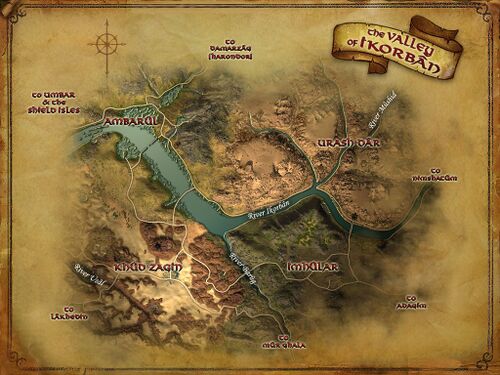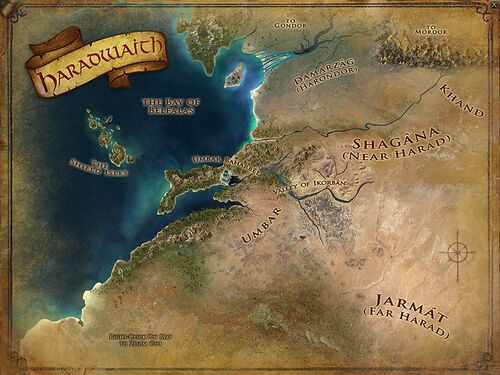Valley of Ikorbân

The Valley of Ikorbân is a fertile and strategically significant territory in Shagâna, part of the greater land of Haradwaith. It encompasses the four regions of Ambarûl, Khûd Zagin, Imhûlar, and Urash Dâr, and serves as the ancestral homeland of the Ikorbâni people. Its landscape is dominated by the winding river Ikorbân, which carves deep valleys and provides a vital source of water and irrigation, supporting both agriculture and trade throughout the territory.
The valley has long been a crossroads of civilizations and cultures. Its fertile lands and natural defenses attracted settlers, conquerors, and merchants over millennia, resulting in a patchwork of city-states, fortified towns, and scattered rural settlements. Historically, the valley has experienced frequent conflict, ranging from internal civil wars to invasions from neighboring territories such as Khand and Harondor, leaving a legacy of shifting political allegiances and contested rule. Despite this turbulent history, the Ikorbâni developed a resilient and adaptive culture, blending influences from neighboring peoples while retaining distinct local traditions.
The valley is bounded geographically by the Cape of Umbar to the west, Harondor to the north, Khand to the east, and the desert lands of Jarmát to the south. Its terrain varies from fertile river plains and rolling hills to rugged canyons and plateau regions. These natural features have historically shaped settlement patterns, trade routes, and military campaigns within the valley.
The name "Valley of Ikorbân" derives from the river Ikorbân, which flows from the highlands in the east through the heart of the valley and into the westerern plains, and on into the Bay of Umbar. The river is central to the life of the valley, influencing agriculture, trade, culture, and the placement of key settlements. Cities such as Kûr Anzar and Ambarûl owe their prosperity to proximity to the river, while historical sites like the Tombs of Esh-kimâkhi and the Watcher of Urmâkh are situated along its banks, reflecting the intertwined nature of geography, history, and culture in the territory.
The valley’s importance extends beyond its physical resources. It has served as a major trade corridor between Harondor and the southern reaches of Harad, connecting local economies with distant markets. During the height of the Shârate of Hamât, the valley was unified under central rule, fostering periods of economic growth and cultural flourishing, such as the Years of Joy under Aragín the Queller. Later, civil strife and foreign invasions fragmented the valley, prompting the creation of the Ibili Council in Ambarûl to maintain regional stability.
The Valley of Ikorbân was added to the game on November 6th, 2024.
Connected Locations
- Cape of Umbar
- Lâkhedin (not yet in-game)
- Harondor (not yet in-game)
- Nimshatûm (not yet in-game)
- Adagím (not yet in-game)
- Mûr Ghala (not yet in-game)
Maps
-
The Valley of Ikorbân map
-
The Valley of Ikorbân as seen on the Haradwaith land map.
| Regions within the The Valley of Ikorbân
| ||
|---|---|---|
| Ambarûl • Imhûlar • Khûd Zagin • Urash Dâr |
| Regions within Harad
| ||
|---|---|---|
| In-game: Shagâna: Valley of Ikorbân (Ambarûl • Imhûlar • Khûd Zagin • Urash Dâr) Not yet in-game: Shagâna: Mûr Ghala (Adagím • An Shêru • Idagâl • Kighân) • Lâkhedin • Nimshatûm • Silapesh |

